Unit 1 Know yourself Grammar 课件(23张PPT)2023-2024学年牛津译林版九年级英语上册
文档属性
| 名称 | Unit 1 Know yourself Grammar 课件(23张PPT)2023-2024学年牛津译林版九年级英语上册 | 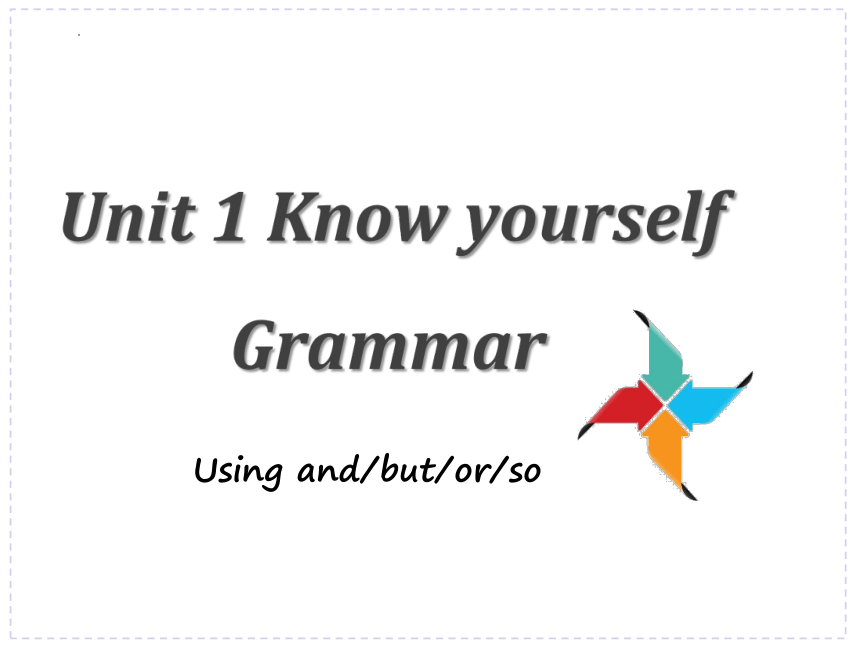 | |
| 格式 | pptx | ||
| 文件大小 | 1.0MB | ||
| 资源类型 | 教案 | ||
| 版本资源 | 牛津译林版 | ||
| 科目 | 英语 | ||
| 更新时间 | 2023-07-18 20:23:09 | ||
图片预览

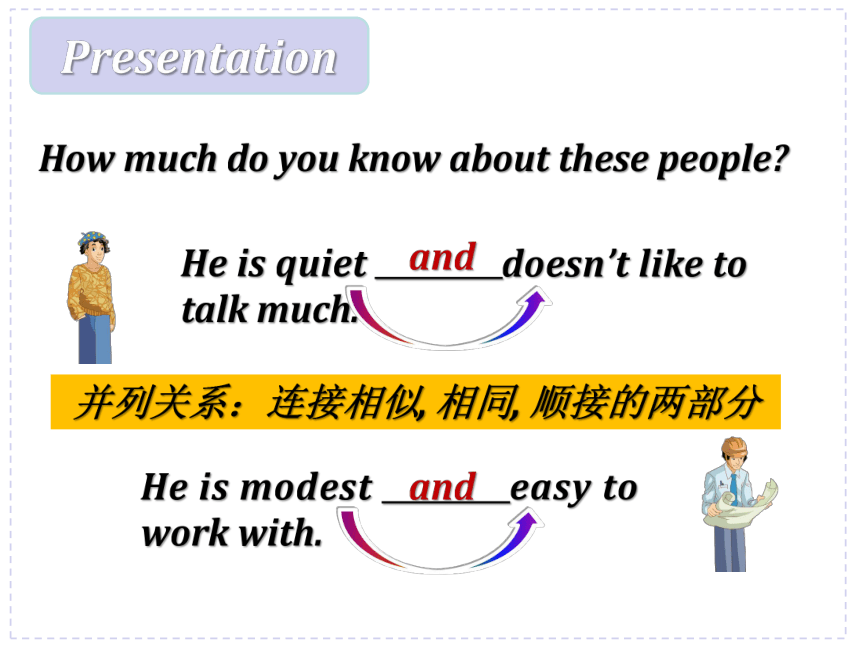
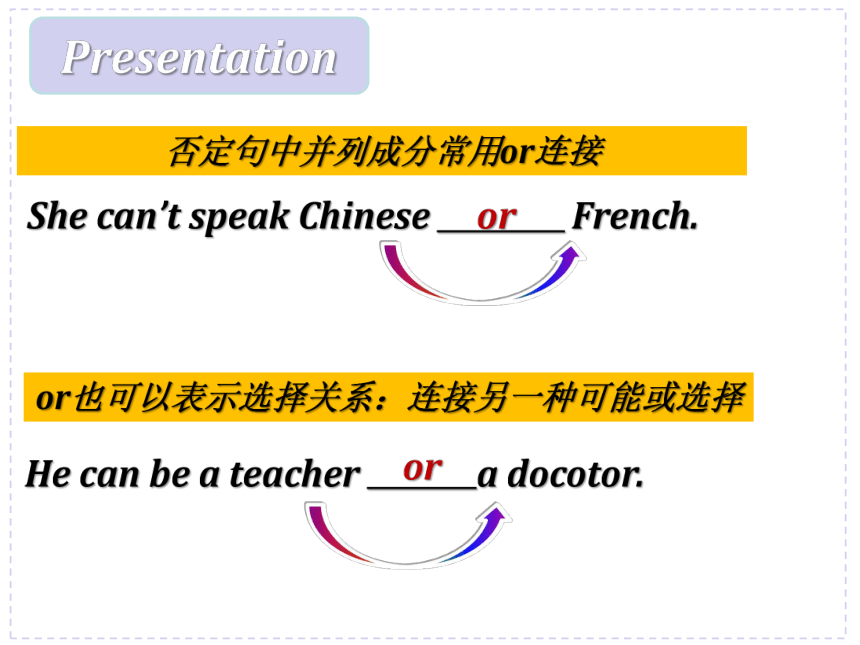

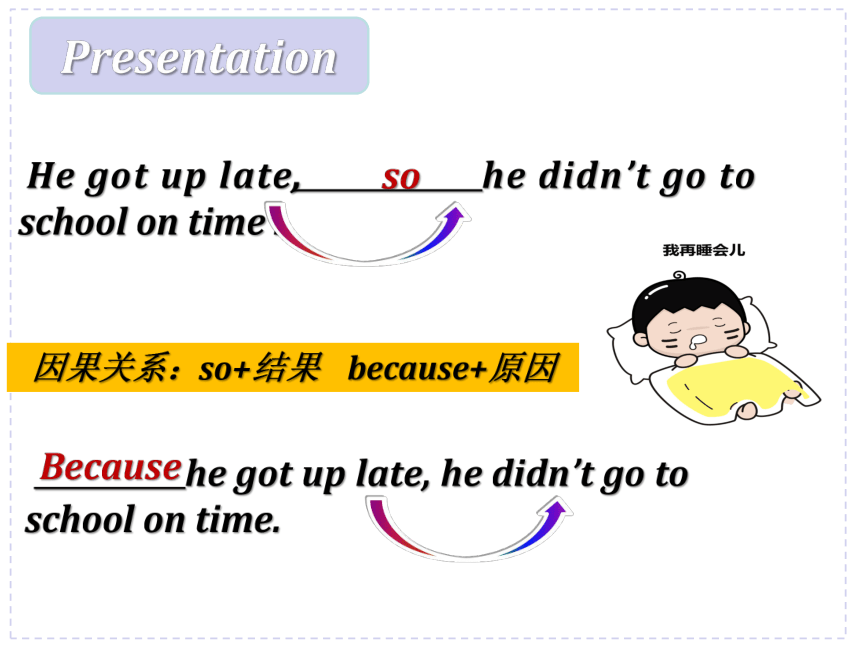
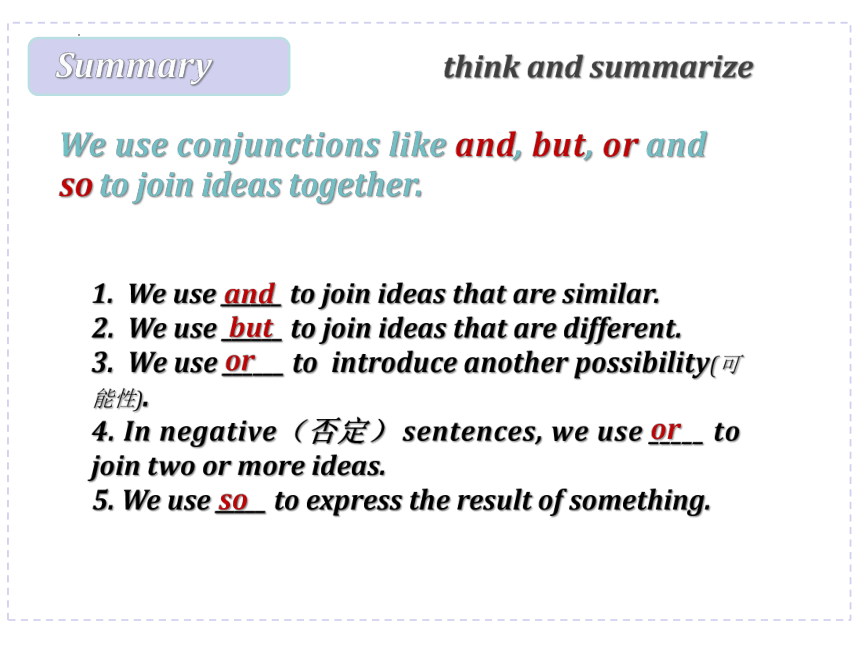
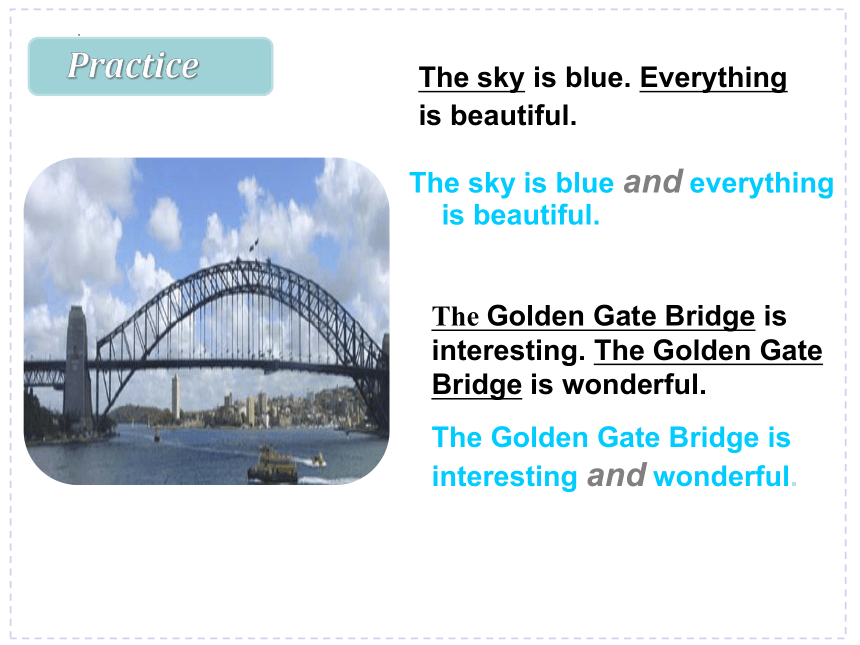
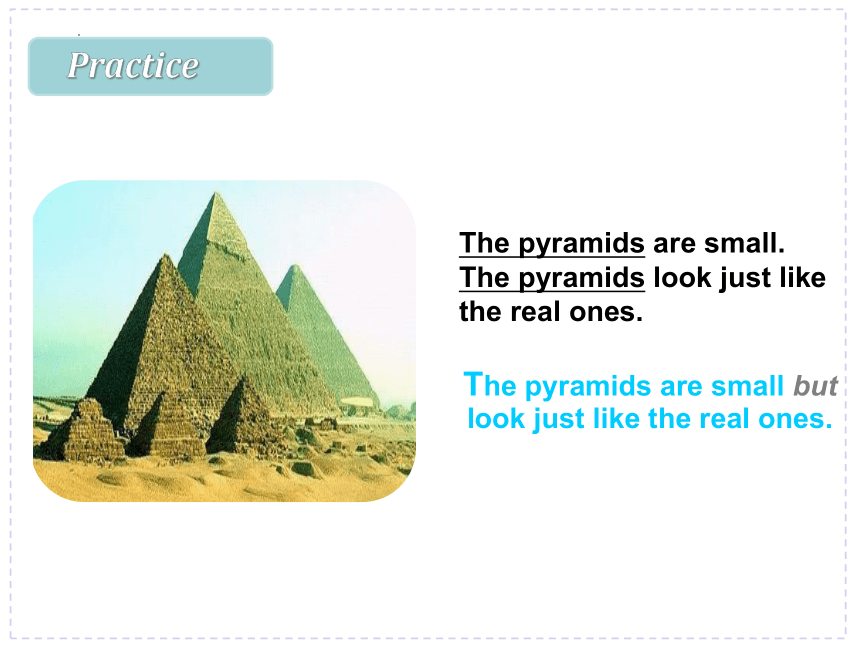

文档简介
(共23张PPT)
Unit 1 Know yourself
Grammar
Using and/but/or/so
Presentation
How much do you know about these people
He is quiet doesn’t like to talk much.
and
He is modest easy to work with.
and
并列关系:连接相似, 相同, 顺接的两部分
Presentation
She can’t speak Chinese French.
or
He can be a teacher a docotor.
or
否定句中并列成分常用or连接
or也可以表示选择关系:连接另一种可能或选择
Presentation
She is strict with us, she is kind and patient.
but
He worked hard, he failed the exam.
but
He worked hard, ,he failed the exam.
however
but/however 转折关系:连接相反,转折关系
Presentation
He got up late, he didn’t go to school on time .
so
he got up late, he didn’t go to school on time.
Because
因果关系:so+结果 because+原因
Summary
think and summarize
We use conjunctions like and, but, or and so to join ideas together.
1. We use ______ to join ideas that are similar.
2. We use ______ to join ideas that are different.
3. We use ______ to introduce another possibility(可能性).
4. In negative(否定) sentences, we use _____ to join two or more ideas.
5. We use _____ to express the result of something.
and
but
or
or
so
The sky is blue. Everything
is beautiful.
The sky is blue and everything is beautiful.
The Golden Gate Bridge is interesting. The Golden Gate Bridge is wonderful.
The Golden Gate Bridge is interesting and wonderful.
Practice
The pyramids are small. The pyramids look just like the real ones.
The pyramids are small. The pyramids look just like the real ones.
The pyramids are small but
look just like the real ones.
Practice
I will go to France by plane. I will go to France by train.
I will go to France by plane or by train.
Practice
1. Kitty is kind. Sometimes she is impatient.
2. Billy would not accept others’ advice. Billy would not think twice.
3. Judy is gentle. Judy never gets angry with others.
4. Suzy worries too much. She cannot sleep well sometimes.
Production
Billy would neither accept others’ advice nor think twice.
Kitty is kind but impatient sometimes.
Judy is gentle so he never argue with others.
Suzy worries too much so she cannot sleep well sometimes.
Presentation
Tom loves reading.
Jerry loves reading.
both… and…
Both Tom and Jerry love reading.
not only…but (also)
Tom is cute.
Tom is clever.
Tom enjoys playing baseball.
Jerry enjoys playing baseball.
Tom is not only cute but (also) clever.
Not only Tom but (also) Jerry enjoys playing baseball.
Presentation
either ... or ...
Tom is ready to take on new challenges.
Jerry is ready to take on new challenges.
Either Tom or Jerry is ready to take on new challenges.
Tom doesn’t like singing.
Jerry doesn’t like singing.
Neither Tom nor Jerry likes singing.
neither ... nor ...
We use both … and … to emphasize that something is true not just of one person, thing or situation, but of another too.
We use not only … but (also) … to add another fact to something you have mentioned.
We use either … or … to mean one or the other, this or that, he or she, etc.
We use neither … nor … to mean not this one and not the other, not this and not that, not he and not she, etc.
Summary
When we use the conjunctions to connect two subjects, the verb form after both … and … is always plural.
But the verb from after not only … but also …, either … or … and neither … nor … can be plural or singular, depending on the subject closer to the verb. (就近原则)
e.g.
Either Simon or David _____(be) ready to take on new challenges.
Neither Millie nor her friends ______(know) about types of personality.
Attention
is
know
Amy’s family
Neither nor
Both and
Either or
either
or
not only
but also
not only
Amy’s classmates
Amy: I have learnt about jobs and personalities recently.
Suzy: Really What jobs do you think our classmates can
do in the future
Amy: I think Millie would make an excellent teacher.
She’s (1) ________ willing to work with children ________
patient with them.
Suzy: What about Simon
Amy: He’s active and good at playingfootball. I think he
can be (2)______ a PE teacher ____ a football player.
but also
either
or
Neither
Suzy: Do you think David and Lisa can be artists
Amy: They are very organized, but artists should be
creative. (3) ______ David’s _____ Lisa’s personality
(4)____(be) suitable for being an artist, I’m afraid.
Suzy: Who can be a manager
Amy: (5)_____ Billy _____ Paul (6)____(be) very confident
and energetic. I think they can be managers.
Suzy: How can I learn about jobs and personalities
Amy: You can read about them (7)_______ from some
books ___ on the Internet.
nor
is
Both and
either
or
are
1. Mary likes music___Tom is found of sports.
A. and B. but C. both A and B
2. I failed again, ___ I won’t give up.
A. and B. but C. so
3. This is my first lesson, __ I don’t know your names.
A. and B. but C. so
and : 表对等 “和、并且”
but: 表转折 “但是”
so: 表因果 “所以”
4. Which do you like better, apples, __ pears
A. and B. but C. or
5. Now we have no time _____ money.
A. so B. and C. or?
or: 1. 用于疑问句, 表选择
2. 用于否定句, 表并列
6. Try your best __ you’ll make more progress.
A. and B. but C. or
7. Don’t lose heart, __ you’ll lose all.
A. and B. so C. or
and 和 or 都可以在祈使句中使用.
and 通常是比较好的结果;
or 则表示不愉快或不理想的结果.
8. It’s getting warmer __ warmer.
A. and B. but C. or
9. He or the twins __ the USA.
A. comes from B. come from
C. is from
10. Not Tom but I ___ going to give the talk.
A. am B. is C. are
adj.比 + and + adj.比 表示越来越…
A or B 和 not A but B 结构作主语时,谓语动词要使用就近原则。
11. Although I have passed the exam, ___ I am not pleased with the result.
A. and B. but C. /
although 和 but 不能同时出现。
12. Both Peter and I ___ going to Guangzhou.
A. are B. is C. am
13. Either apples or rice __ Ok. I am hungry.
A. are B. is C. /
14. Neither I nor my parents ___ to tell you the truth.
A. wants B. want C. is going to
15. Not only I but also Jane __ sure that we’ll win.
A. is B. are C. am
both…and…
either…or…
neither…nor…
not only…but also…
以上结构做主语,除both…and… 谓语要用复数外,其余都使用就近原则。
Unit 1 Know yourself
Grammar
Using and/but/or/so
Presentation
How much do you know about these people
He is quiet doesn’t like to talk much.
and
He is modest easy to work with.
and
并列关系:连接相似, 相同, 顺接的两部分
Presentation
She can’t speak Chinese French.
or
He can be a teacher a docotor.
or
否定句中并列成分常用or连接
or也可以表示选择关系:连接另一种可能或选择
Presentation
She is strict with us, she is kind and patient.
but
He worked hard, he failed the exam.
but
He worked hard, ,he failed the exam.
however
but/however 转折关系:连接相反,转折关系
Presentation
He got up late, he didn’t go to school on time .
so
he got up late, he didn’t go to school on time.
Because
因果关系:so+结果 because+原因
Summary
think and summarize
We use conjunctions like and, but, or and so to join ideas together.
1. We use ______ to join ideas that are similar.
2. We use ______ to join ideas that are different.
3. We use ______ to introduce another possibility(可能性).
4. In negative(否定) sentences, we use _____ to join two or more ideas.
5. We use _____ to express the result of something.
and
but
or
or
so
The sky is blue. Everything
is beautiful.
The sky is blue and everything is beautiful.
The Golden Gate Bridge is interesting. The Golden Gate Bridge is wonderful.
The Golden Gate Bridge is interesting and wonderful.
Practice
The pyramids are small. The pyramids look just like the real ones.
The pyramids are small. The pyramids look just like the real ones.
The pyramids are small but
look just like the real ones.
Practice
I will go to France by plane. I will go to France by train.
I will go to France by plane or by train.
Practice
1. Kitty is kind. Sometimes she is impatient.
2. Billy would not accept others’ advice. Billy would not think twice.
3. Judy is gentle. Judy never gets angry with others.
4. Suzy worries too much. She cannot sleep well sometimes.
Production
Billy would neither accept others’ advice nor think twice.
Kitty is kind but impatient sometimes.
Judy is gentle so he never argue with others.
Suzy worries too much so she cannot sleep well sometimes.
Presentation
Tom loves reading.
Jerry loves reading.
both… and…
Both Tom and Jerry love reading.
not only…but (also)
Tom is cute.
Tom is clever.
Tom enjoys playing baseball.
Jerry enjoys playing baseball.
Tom is not only cute but (also) clever.
Not only Tom but (also) Jerry enjoys playing baseball.
Presentation
either ... or ...
Tom is ready to take on new challenges.
Jerry is ready to take on new challenges.
Either Tom or Jerry is ready to take on new challenges.
Tom doesn’t like singing.
Jerry doesn’t like singing.
Neither Tom nor Jerry likes singing.
neither ... nor ...
We use both … and … to emphasize that something is true not just of one person, thing or situation, but of another too.
We use not only … but (also) … to add another fact to something you have mentioned.
We use either … or … to mean one or the other, this or that, he or she, etc.
We use neither … nor … to mean not this one and not the other, not this and not that, not he and not she, etc.
Summary
When we use the conjunctions to connect two subjects, the verb form after both … and … is always plural.
But the verb from after not only … but also …, either … or … and neither … nor … can be plural or singular, depending on the subject closer to the verb. (就近原则)
e.g.
Either Simon or David _____(be) ready to take on new challenges.
Neither Millie nor her friends ______(know) about types of personality.
Attention
is
know
Amy’s family
Neither nor
Both and
Either or
either
or
not only
but also
not only
Amy’s classmates
Amy: I have learnt about jobs and personalities recently.
Suzy: Really What jobs do you think our classmates can
do in the future
Amy: I think Millie would make an excellent teacher.
She’s (1) ________ willing to work with children ________
patient with them.
Suzy: What about Simon
Amy: He’s active and good at playingfootball. I think he
can be (2)______ a PE teacher ____ a football player.
but also
either
or
Neither
Suzy: Do you think David and Lisa can be artists
Amy: They are very organized, but artists should be
creative. (3) ______ David’s _____ Lisa’s personality
(4)____(be) suitable for being an artist, I’m afraid.
Suzy: Who can be a manager
Amy: (5)_____ Billy _____ Paul (6)____(be) very confident
and energetic. I think they can be managers.
Suzy: How can I learn about jobs and personalities
Amy: You can read about them (7)_______ from some
books ___ on the Internet.
nor
is
Both and
either
or
are
1. Mary likes music___Tom is found of sports.
A. and B. but C. both A and B
2. I failed again, ___ I won’t give up.
A. and B. but C. so
3. This is my first lesson, __ I don’t know your names.
A. and B. but C. so
and : 表对等 “和、并且”
but: 表转折 “但是”
so: 表因果 “所以”
4. Which do you like better, apples, __ pears
A. and B. but C. or
5. Now we have no time _____ money.
A. so B. and C. or?
or: 1. 用于疑问句, 表选择
2. 用于否定句, 表并列
6. Try your best __ you’ll make more progress.
A. and B. but C. or
7. Don’t lose heart, __ you’ll lose all.
A. and B. so C. or
and 和 or 都可以在祈使句中使用.
and 通常是比较好的结果;
or 则表示不愉快或不理想的结果.
8. It’s getting warmer __ warmer.
A. and B. but C. or
9. He or the twins __ the USA.
A. comes from B. come from
C. is from
10. Not Tom but I ___ going to give the talk.
A. am B. is C. are
adj.比 + and + adj.比 表示越来越…
A or B 和 not A but B 结构作主语时,谓语动词要使用就近原则。
11. Although I have passed the exam, ___ I am not pleased with the result.
A. and B. but C. /
although 和 but 不能同时出现。
12. Both Peter and I ___ going to Guangzhou.
A. are B. is C. am
13. Either apples or rice __ Ok. I am hungry.
A. are B. is C. /
14. Neither I nor my parents ___ to tell you the truth.
A. wants B. want C. is going to
15. Not only I but also Jane __ sure that we’ll win.
A. is B. are C. am
both…and…
either…or…
neither…nor…
not only…but also…
以上结构做主语,除both…and… 谓语要用复数外,其余都使用就近原则。
